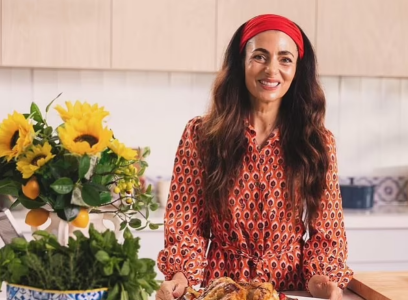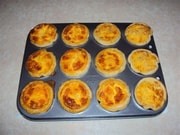Are you making this mistake at restaurants? Top chef reveals the one dish she never orders
By
- Replies 2
If you’re anything like us, there’s nothing quite as comforting as a big, steaming bowl of pasta—especially when you’re out for dinner and don’t feel like cooking. But what if we told you that one of Australia’s most celebrated Italian chefs almost never orders pasta at a restaurant? That’s right! Silvia Colloca, the Italian-Australian cookbook author and TV personality, has a surprising rule when it comes to dining out: she avoids pasta, and she’s got a very good reason.
Now, before you start thinking this is some sort of food snobbery, Silvia is quick to set the record straight. ‘It’s not snobby,’ she insists. In fact, her reasoning is all about quality and tradition—something we can all appreciate, especially when it comes to a dish as beloved as pasta.
Why Pasta Is Off the Menu for Silvia Colloca
Silvia, who’s made a name for herself by championing the soulful simplicity of traditional Italian cuisine, is a stickler for one thing: perfectly cooked, al dente pasta. For her, there’s nothing worse than a plate of noodles that’s been boiled to oblivion. ‘It’s more important than you think and not as snobby as it sounds,’ she told the Sydney Morning Herald.
Al dente, for those who might need a refresher, means ‘to the tooth’ in Italian. It’s that magical point where the pasta is cooked through but still has a bit of bite—a texture that’s essential for the true Italian experience. Overcooked pasta, on the other hand, is a deal breaker for Silvia. And let’s be honest, who hasn’t been disappointed by a soggy, limp bowl of spaghetti at some point?
A Chef’s Secret for Perfect Pasta at Home
Silvia’s advice for home cooks is simple but effective: always take your pasta off the boil a couple of minutes before the packet suggests. Why? Because the pasta will keep cooking from the residual heat, and you’ll avoid the dreaded mushy texture. For example, if the instructions say 12 minutes, aim for 10 or 11. It’s a small change that makes a world of difference.
And it’s not just about personal preference—Silvia’s passion for pasta is so strong that she’s even an ambassador for San Remo, a family-run pasta brand that shares her commitment to al dente perfection.
How to Choose the Best Dried Pasta at the Supermarket
But the story doesn’t end at the restaurant table. Another pasta expert, chef Francesco Mattana (who splits his time between London and Sardinia), has gone viral for his tips on picking the best-dried pasta at the shops. According to Francesco, the secret is in the colour and texture.
Forget the bright yellow, shiny pasta you often see on supermarket shelves. That’s usually a sign it’s been dried quickly at high heat, which can ruin both the flavour and the texture. Instead, look for pasta that’s a pale, floury ivory colour—this means it’s been dried slowly at a low temperature, preserving nutrients and taste.
Francesco also recommends running your fingers along the pasta. The best quality pasta should feel rough and slightly opaque, not smooth and glossy. This roughness (often labelled as ‘bronze drawn’ or ‘trafilatura al bronzo’) helps sauces cling to the noodles, giving you that luxurious, restaurant-quality finish at home.
Brands That Get the Chef’s Tick of Approval
If you’re wondering which brands to look for, shoppers and chefs alike rave about De Cecco, Barilla, Molisana, Garofalo, and Rummo. These brands are known for their traditional methods and high-quality durum wheat semolina, which means your pasta will hold its shape and never go mushy.
The Takeaway: Don’t Settle for Soggy Pasta!
So, next time you’re tempted to order pasta at a restaurant, take a page from Silvia Colloca’s book: unless you know it’ll be cooked perfectly al dente, you might want to give it a miss. And when you’re shopping for dried pasta, skip the shiny yellow stuff and look for something with a rough edge—literally!
 Have you ever been disappointed by a plate of overcooked pasta at a restaurant? Do you have a favourite brand or a secret tip for perfect pasta at home? Share your stories, tips, and even your pasta disasters in the comments below. Let’s help each other make every meal a little more ‘al dente’!
Have you ever been disappointed by a plate of overcooked pasta at a restaurant? Do you have a favourite brand or a secret tip for perfect pasta at home? Share your stories, tips, and even your pasta disasters in the comments below. Let’s help each other make every meal a little more ‘al dente’!
Now, before you start thinking this is some sort of food snobbery, Silvia is quick to set the record straight. ‘It’s not snobby,’ she insists. In fact, her reasoning is all about quality and tradition—something we can all appreciate, especially when it comes to a dish as beloved as pasta.
Why Pasta Is Off the Menu for Silvia Colloca
Silvia, who’s made a name for herself by championing the soulful simplicity of traditional Italian cuisine, is a stickler for one thing: perfectly cooked, al dente pasta. For her, there’s nothing worse than a plate of noodles that’s been boiled to oblivion. ‘It’s more important than you think and not as snobby as it sounds,’ she told the Sydney Morning Herald.
Al dente, for those who might need a refresher, means ‘to the tooth’ in Italian. It’s that magical point where the pasta is cooked through but still has a bit of bite—a texture that’s essential for the true Italian experience. Overcooked pasta, on the other hand, is a deal breaker for Silvia. And let’s be honest, who hasn’t been disappointed by a soggy, limp bowl of spaghetti at some point?
A Chef’s Secret for Perfect Pasta at Home
Silvia’s advice for home cooks is simple but effective: always take your pasta off the boil a couple of minutes before the packet suggests. Why? Because the pasta will keep cooking from the residual heat, and you’ll avoid the dreaded mushy texture. For example, if the instructions say 12 minutes, aim for 10 or 11. It’s a small change that makes a world of difference.
And it’s not just about personal preference—Silvia’s passion for pasta is so strong that she’s even an ambassador for San Remo, a family-run pasta brand that shares her commitment to al dente perfection.
How to Choose the Best Dried Pasta at the Supermarket
But the story doesn’t end at the restaurant table. Another pasta expert, chef Francesco Mattana (who splits his time between London and Sardinia), has gone viral for his tips on picking the best-dried pasta at the shops. According to Francesco, the secret is in the colour and texture.
Forget the bright yellow, shiny pasta you often see on supermarket shelves. That’s usually a sign it’s been dried quickly at high heat, which can ruin both the flavour and the texture. Instead, look for pasta that’s a pale, floury ivory colour—this means it’s been dried slowly at a low temperature, preserving nutrients and taste.
Francesco also recommends running your fingers along the pasta. The best quality pasta should feel rough and slightly opaque, not smooth and glossy. This roughness (often labelled as ‘bronze drawn’ or ‘trafilatura al bronzo’) helps sauces cling to the noodles, giving you that luxurious, restaurant-quality finish at home.
Brands That Get the Chef’s Tick of Approval
If you’re wondering which brands to look for, shoppers and chefs alike rave about De Cecco, Barilla, Molisana, Garofalo, and Rummo. These brands are known for their traditional methods and high-quality durum wheat semolina, which means your pasta will hold its shape and never go mushy.
The Takeaway: Don’t Settle for Soggy Pasta!
So, next time you’re tempted to order pasta at a restaurant, take a page from Silvia Colloca’s book: unless you know it’ll be cooked perfectly al dente, you might want to give it a miss. And when you’re shopping for dried pasta, skip the shiny yellow stuff and look for something with a rough edge—literally!
Key Takeaways
- Chef Silvia Colloca rarely orders pasta when dining out, as she finds overcooked pasta a deal breaker and insists it must be served perfectly al dente.
- Colloca recommends cooking pasta a couple of minutes less than the packet suggests, letting residual heat finish the job for the ideal texture.
- Chef Francesco Mattana advises shoppers to pick dry pasta that’s pale, floury, and rough to the touch—signs of slow drying and quality; he warns against bright yellow, shiny types.
- Quality pasta, made with good durum wheat semolina and bronze-cut, holds its shape and allows the sauce to cling better, making for a superior meal both at home and in restaurants.








